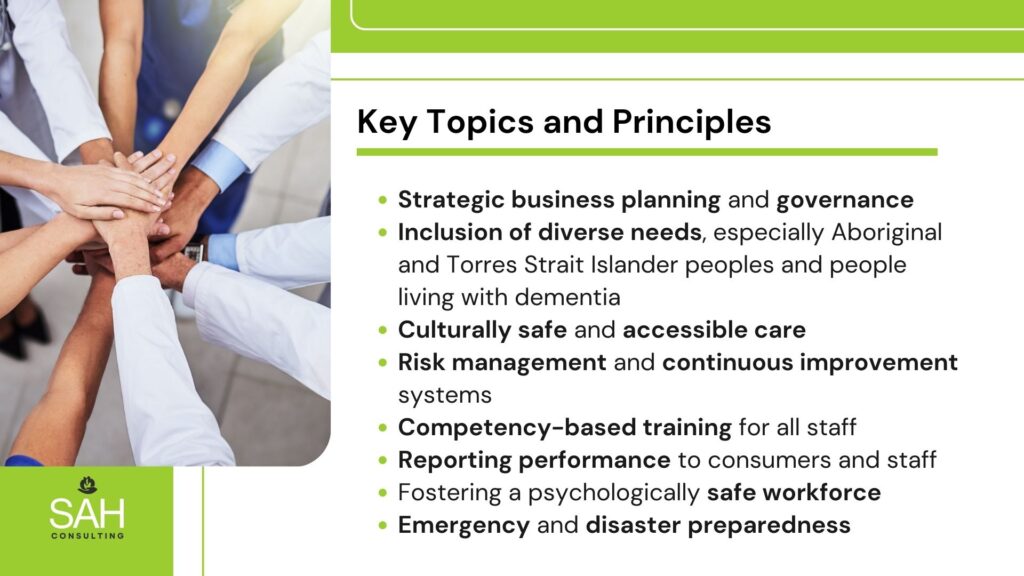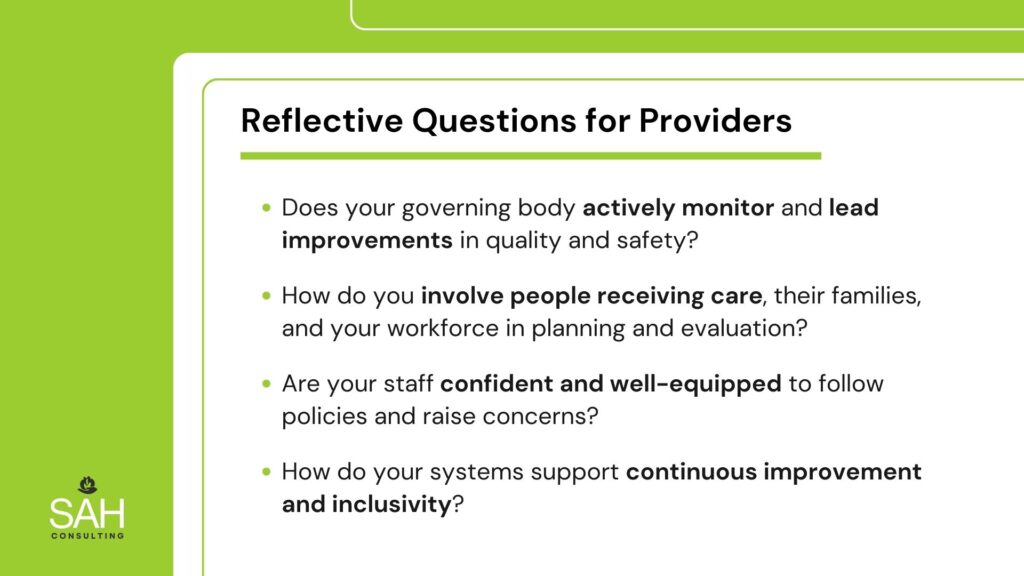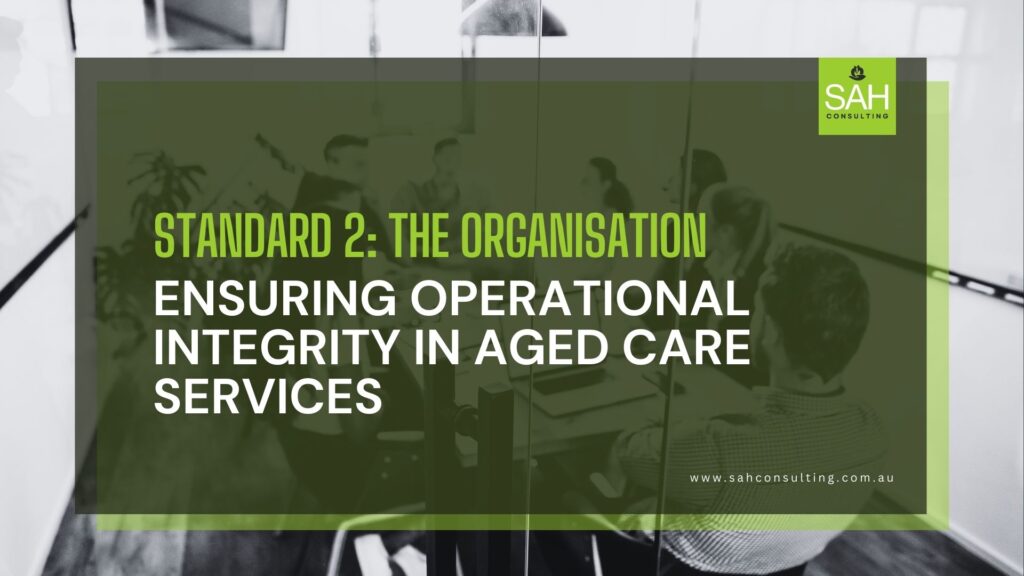Strengthened Quality Standard 2 focuses on organisational accountability in aged care services. It sets out what is expected from providers to ensure safe, quality, and person-centred care. The standard emphasises strong governance, effective planning, capable workforce support, and clear communication.
Responsibility sits with the governing body, which must lead by example and embed a culture of continuous improvement. This standard applies to providers in Categories 4, 5, and 6 under the Support at Home programme. Its goal is to ensure operational integrity in aged care from the top down.
What Standard 2 Means
Standard 2 begins with the voices that matter most:
For older people: “I have confidence in my service provider.”
For workers: “I feel empowered to do my job well.”
This standard ensures that the organisation, led by its governing body, is responsible for driving safety, quality, and person-centred care. It is about setting the tone from the top. Leaders must create a culture that supports staff, builds trust with older people, and prioritises continuous improvement.
The governing body is expected to lead strategic planning, ensure effective systems are in place, and model accountability. Staff must be equipped and supported to deliver care that meets individual needs. This approach aligns with the strengthened code of conduct for aged care, reinforcing professional responsibility across the sector.
Key Topics and Principles
Providers must focus on the following key areas to meet the requirements of Standard 2:
- Strategic business planning and governance
- Inclusion of diverse needs, especially Aboriginal and Torres Strait Islander peoples and people living with dementia
- Culturally safe and accessible care
- Risk management and continuous improvement systems
- Competency-based training for all staff
- Reporting performance to consumers and staff
- Fostering a psychologically safe workforce
- Emergency and disaster preparedness

Required Outcomes and Actions
Standard 2 includes 10 outcomes and 43 actions. Six actions introduce new expectations, while the rest build on or clarify existing responsibilities. They focus on strengthening governance, fostering a culture of safety and improvement, and supporting a capable and responsive workforce.
Outcome 2.1: Partnering with people
Meaningful and active partnerships with older people inform organisational priorities and continuous improvement.
Actions:
- Partner with older people to set priorities and strategic directions for care and services.
- Support participation of diverse older people, including Aboriginal and Torres Strait Islander peoples.
- Engage older people in the design, delivery, evaluation, and improvement of care and services.
Outcome 2.2: Quality and safety culture
A culture of quality and safety is embedded across the organisation.
Actions:
- Promote continuous improvement in care and services.
- Integrate quality and safety into strategic planning.
- Ensure leadership commitment to the quality of life for older people.
- Identify and manage enterprise risks affecting quality and safety.
Outcome 2.3: Accountability and quality system
Clear accountabilities and a quality system support safe and effective care.
Actions:
- Define roles and responsibilities for quality and safety.
- Implement evidence-based practices.
- Monitor organisational performance in delivering care.
- Practise open disclosure when things go wrong.
- Ensure governance structures support quality care.
Outcome 2.4: Risk management
Risks to care quality and safety are identified and managed.
Actions:
- Identify and assess enterprise risks.
- Develop and implement risk mitigation strategies.
- Review and update risk management plans regularly.
Outcome 2.5: Incident management
Incidents are managed promptly to improve care and prevent recurrence.
Actions:
- Implement a system for timely incident reporting.
- Investigate incidents using evidence-based methods.
Outcome 2.6: Feedback and complaint management
Feedback and complaints are managed effectively to improve services.
Actions:
- Provide accessible avenues for feedback and complaints.
- Respond to feedback and complaints in a timely manner.
- Use feedback and complaints to drive continuous improvement.
- Support advocates and representatives in the feedback process.
Outcome 2.7: Information management
Information is managed securely and used to support care delivery.
Actions:
- Ensure information privacy and security.
- Obtain informed consent for information sharing.
- Use information to support evidence-based care.
Outcome 2.8: Workforce planning
Workforce planning ensures sufficient and capable staff to deliver quality care.
Actions:
- Assess current and future workforce needs.
- Develop strategies to recruit and retain staff.
- Promote psychological safety within the workforce.
- Align workforce planning with strategic objectives.
Outcome 2.9: Human resource management
Human resource practices support a competent and engaged workforce.
Actions:
- Implement competency-based training programs.
- Monitor and review staff performance regularly.
- Provide opportunities for professional development.
- Ensure staff understand their roles and responsibilities.
Outcome 2.10: Emergency and disaster management
Preparedness for emergencies and disasters ensures continuity of care.
Actions:
- Develop comprehensive emergency and disaster plans.
- Engage with older people in emergency planning.
- Conduct regular drills and training.
- Review and update plans based on lessons learned.
Of the 43 actions in this Standard, 6 are new topics or expectations. The remaining 37 align with or clarify current Quality Standards and other existing provider responsibilities.
Demonstrating Conformance
To meet Standard 2, providers must show evidence that their systems, workforce, governance, and engagement processes are effective and aligned with the actions under this Standard. The focus is on practical implementation—not just having policies, but using them to drive real outcomes.
Systems and Documentation
Providers must maintain clear, up-to-date, and accessible documentation. This includes policies, procedures, frameworks, and records that reflect current practices. Staff should be trained to understand and use these documents in daily operations. Documentation must show how the organisation meets each action under Standard 2 and supports integrity in aged care.
Monitoring and Continuous Improvement
Services must regularly assess whether systems are working as intended. Use tools like internal audits, compliance checklists, and staff or consumer feedback to identify gaps. Document how feedback leads to changes. Continuous improvement should be systematic, not reactive.
Workforce Capability and Safety
All staff must receive ongoing, competency-based training relevant to their roles. Assess staff skills regularly and address any gaps. Psychological safety must also be monitored—workers should feel safe to speak up, ask questions, and report concerns without fear of negative consequences.
Strategic and Transparent Governance
The governing body must be actively involved in setting direction and reviewing performance. This includes monitoring quality indicators, workforce data, and consumer outcomes. Governance activities should be clearly documented and linked to quality improvement plans. Leadership must be visible and accountable.
Partnerships with Older People and Diverse Communities
Services must involve older people and diverse communities in planning, delivering, and reviewing care. This includes Aboriginal and Torres Strait Islander peoples, people living with dementia, and those with culturally or linguistically diverse backgrounds. Engagement must go beyond consultation—co-design and shared decision-making are expected.
Reflective Questions for Providers
These questions help aged care providers assess how well they are meeting the requirements of Strengthened Quality Standard 2. Use them to identify strengths, gaps, and areas for improvement. Honest reflection supports governance that upholds accountability, quality, and integrity in aged care.
- Does your governing body actively monitor and lead improvements in quality and safety?
- How do you involve people receiving care, their families, and your workforce in planning and evaluation?
- Are your staff confident and well-equipped to follow policies and raise concerns?
- How do your systems support continuous improvement and inclusivity?
Answering these questions can guide providers in aligning their operations with the Standard and driving meaningful change.

SAH Consulting: Guiding Providers Through Compliance and Registration
At SAH Consulting, we help aged care providers across Australia navigate the Support at Home registration process with clarity and confidence. Our focus is on making sure you meet the Strengthened Quality Standards, especially Standard 2, which centres on governance, planning, and care systems.
We understand the pressures of compliance and the importance of getting it right. That’s why we work alongside you to develop practical solutions that align with your organisation’s goals. Whether it’s strengthening your internal processes or reviewing your policies in aged care, we ensure everything is fit for purpose and used effectively by your team.
Final Thoughts
Quality Standard 2 is the backbone of accountability in aged care. It shapes how organisations lead, support their workforce, and deliver safe, person-centred services. This Standard isn’t just about meeting requirements—it’s about leading with integrity in aged care, setting the tone from the top, and building a culture that values continuous improvement.
At SAH Consulting, we’re here to help you turn compliance into action. If you’re preparing for Support at Home registration or looking to strengthen your governance and care systems, get in touch. We’ll guide you every step of the way.
